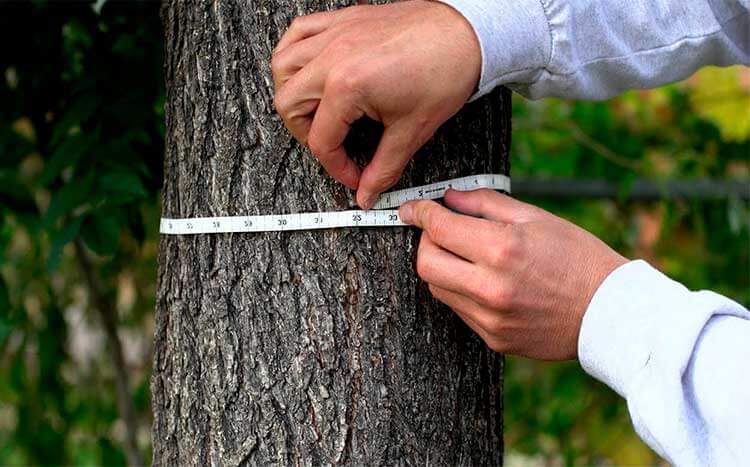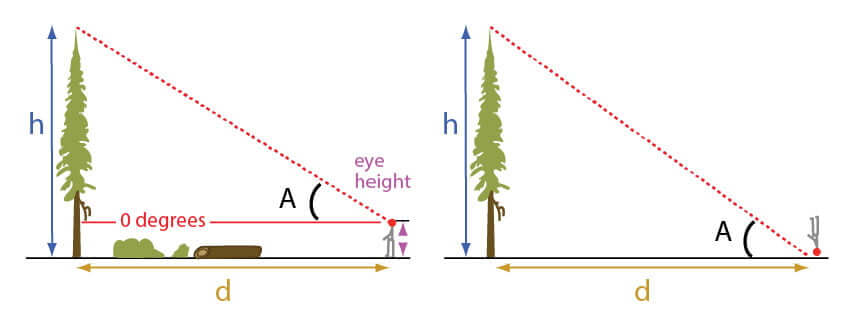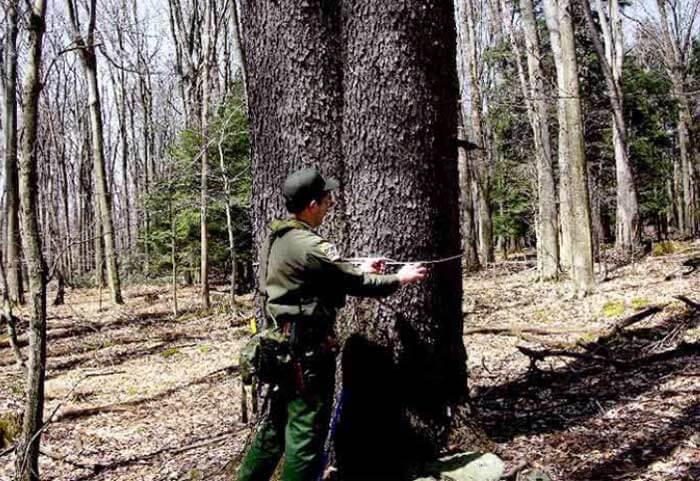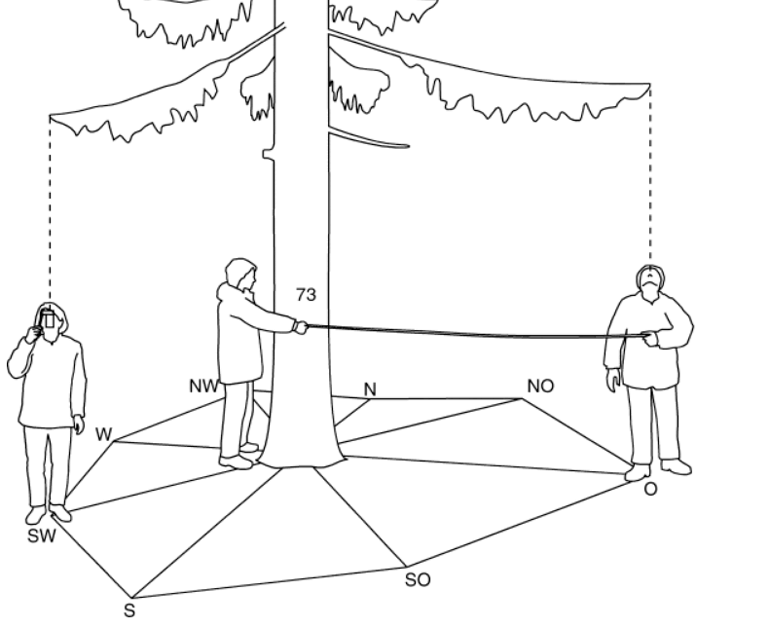Determining a tree’s height and diameter at breast height (DBH) is crucial to ascertain whether its removal is permitted. Additionally, measurements of a tree can reveal valuable insights about it. For example, by measuring a tree’s diameter, arborists can assess its worth, growth prospects, and the necessary amount of fertilizer at a given time.
The most common tree measurements include DBH (diameter at breast height), height, and crown spread. These measurements can be done in different ways. The method and measurement you choose depend on the data you are after the size of the tree and other factors.

What we cover
ToggleTree Measurement Techniques
There are several tree measurement1 techniques and tools you can use depending on the type of measurement and the tools at your disposal. For instance, you can use the string and tape measure method to measure the DBH of a tree at home. Professionals with access to better tools can employ more accurate and sophisticated techniques.
Common tree measurement techniques used in the industry
| Type of Measurement | Techniques | Tools Required |
|---|---|---|
| DBH (Diameter at Breast Height)/Cross Section | String and tape, Azimuth technique, Monocular-Reticle technique, Photographic, | Tape measure, measuring string, marking tools, anchor/Thumbtack |
| Height | Height of a person technique, Pencil technique, Proportion technique, Triangle method, Stick technique, Tangent Method, Sine Method Using Advanced Hypsometers, etc. | Various depending on the method |
| Girth/Circumference | Direct measurement, Caliper method (using diameters), etc. | Tape measure, arms, other measurement equipment |
| Crown | Axis method, Spoke method, | |
| Volume | Frame mapping, Footprint mapping, Remote technique, Canopy mapping, Ground-based measurement techniques, among others | Various tools depending on the technique used. |
Tree Height Measurement Techniques
Tree height can be measured in various ways depending on the tools in use, the purpose of the measurement, the positioning of the tree, and other factors. Some of the most common tree height measurement techniques include:
- Height of a person technique
- Stick technique
- Pencil technique
- Proportions technique
- Triangles method
- Tangent Method
- Sine method Using advanced hypsometers, etc.
The first two techniques are simple and can be used to produce fairly accurate measurements if done correctly. The others, such as triangles or sine techniques are more sophisticated and normally used in scientific research.
The sine method2 produces the most accurate and consistent results regardless of the type of tree being measured or its structure and positioning.
Example using the Height of a Person Technique

Here is how to measure a tree’s height using the height of a person technique3. This technique requires at least two people.
- Measure your helper or partner’s height and record it somewhere for reference.
- Ask them to stand at the base of the tree being measured.
- Now stand in front of the person and hold a pencil or stick in front of you. Move backward away from the tree facing that person. Stop when your viewing perspective shows that the top of the pencil or stick you are holding is aligned with the top of the person’s head and the bottom at their feet.
- Do a rough estimate of how many pencils or sticks it would take to reach the top of the tree being measured from your position.
- Multiply the height of the person you recorded earlier with the number of pencil heights estimated. For instance, if their height is 5.5 Feet/1.6 meters and you estimate 5 pencil heights, the height of the tree can be calculated as 1.6 x 5= 8 meters or roughly 26 feet.
As you can probably tell, this technique is quite straightforward but it has a high error margin. It may also be ineffective for trees with leaning trunks, those sitting on uneven or sunken surfaces, and trees in hard-to-access areas with no straight line of vision.
Tree Girth Measurement
Tree girth measurements or circumference have many uses and can be done using various techniques such as:
- Direct measurement,
- The Caliper method (using diameters), etc.

Example Using the Direct Measurement Method.
Measuring a tree’s girth or circumference involves measuring the trunk at a certain height above its base (usually 4.5 feet). You can do this using a string, flexible measuring tape, outstretched arms, or any other measuring equipment.
Here is how you can get a tree’s correct girth using flexible tape.
- Measure at least 4.5 from the base of the tree with tape and put a marker.
- Wrap your tape around the entire tree at the point marked to take the measurement and record it.
- You can also wrap a string around the tree at the identified height and measure its length to get the circumference.
Note: This is the easiest and most accurate way to measure a tree’s girth. However additional steps may be required for leaning trees, trees with uneven features, and multi-trunk trees.
Tree Crown Measurement
Crown measurements usually give the spread of a particular tree’s living canopy. Tree crown measurements can be used in various ways depending on the purpose of the measurement and technique used.
For instance, crown spread measurements can be used to determine if a tree needs trimming to maintain its balance. Some of the techniques used in tree crown measurement include:
- Axis method
- Spoke method
- Estimating using a crown density-foliage transparency card
- Electronically using densitometers
Crown spread measurements are usually taken by trained arborists to help them in the maintenance of trees.
Example Using the Axis Method

- Assume that the top of the tree whose crown spread is being measured has four points, A, B, C, and D positioned on four corners like a cross or compass.
- Measure the distance from A to D and the distance from C to D. The pairs being measured should be on opposite ends of the cross.
- Add the two measurements to get the average. This is the average crown spread of your tree.
Note that this method requires you to obtain an aerial picture of the tree either using Google satellite imagery or drone footage.
Tip: It’s important to take tree crown measurements as part of regular tree maintenance especially if the tree is growing next to a building or utility. These measurements are technical and can only be done by a trained professional. Use our free tool at the top of the page if you need help locating top-rated tree care professionals or arborists near your location.
Tree Volume Measurement
Tree volume measurements are quite common and can be done in various ways. For instance, the volume of a tree can include the entire tree from top to bottom.
Some of the techniques or methods used to measure tree volume include:
- Frame mapping
- Footprint mapping
- Remote technique
- Canopy mapping
- Ground-based measurement techniques
Tree volume measurements usually involve climbers taking a series of measurements from the top to the bottom of the tree and the resulting figures are computed to determine the volume. It is an intensive process that can only be carried out by trained climbers.
What Is the Diameter at Breast Height DBH?
Diameter-At-Breast-Height or DBH is the standard way to measure the diameter of a standing tree. The tree’s girth or trunk circumference is measured at the breast height of an adult in relation to a tree trunk and the resulting figure is divided by constant PI(3.14) to obtain the DBH if using a normal tape.
If using a tree tape4 with incremental PI measurements on it, DBH can be obtained directly by taking the tape around the tree trunk at breast height. In some countries, breast height is usually given as a standard figure like 4.5 feet for consistency.
Measuring Single Trunk Trees on Level Ground
Measuring the diameter at the breast height of a tree on level ground is straightforward. All you need to do is stand at the base of the tree and mark the measuring point in relation to your breast height or standard breast height. Make sure the point you measure is fairly even for better accuracy even when measuring single-trunk trees.
Measuring Trees at An Angle or On A Slope
Taking any measurements from a tree standing at an angle or on a slope requires more steps. For instance, when measuring DBH on a leaning tree, the tape should be wrapped at an angle of ninety degrees to the axis of the tree to obtain an accurate breast height.
Measuring Trees with A Split Trunk
Splint-trunk trees are measured in a slightly different way as compared to single-trunk trees. To obtain an accurate DBH or circumference, one has to first determine through observing the form of the tree if it is a single tree or two separate trees.
If the conclusion is that it is one tree, then the measurement should be done at the narrowest point between the point where the trunks split and the ground (if the split is below breast height). However, normal breast height should be used if the split is positioned above breast height.
Measuring Multi-Stemmed Trees
Multi-stemmed trees may have two or more stems or trunks connected at some point. These trees usually present a challenge when being measured for DBH or girth. If the trunks appear to represent the fusion of two or more trunks, then the largest trunk should be measured.
Finding the Diameter of The Tree
There are a few techniques used to find the diameter of a tree. However, the basic way to find the diameter of a tree is by using a normal tape measure and a few readily available tools.
Here is how to find the basic diameter of a tree:
- Stand next to the trunk and measure at least 4.5 feet from the bottom of the trunk at ground level. Use a thumbtack, nail, or anchor to mark the point you will be measuring.
- Now run your tape around the tree trunk up to the point where the zero overlaps with the other end. Record the circumference.
- Now divide the recorded circumference with constant PI to get the diameter as shown below.
Tip: There are more sophisticated techniques you can use to get the diameter of a tree especially if the trunk is hard to access, in difficult terrain, leaning, or has an uneven surface. For instance, the monocular-reticle method is used to measure the diameters of trees from a distance of 200 feet or more.
- Krause, S., Sanders, T.G.M., Mund, J-P., & Greve, K. (2019) UAV-Based Photogrammetric Tree Height Measurement for Intensive Forest Monitoring. <https://www.mdpi.com/2072-4292/11/7/758> Accessed: 22-02-2024
- American Forest, (2019) AF-Tree Measuring Guidelines. <https://www.americanforests.org/wp-content/uploads/2014/12/AF-Tree-Measuring-Guidelines_LR.pdf> Accessed: 22-02-2024
- UBC, (2023) Height measurements. <https://bigtrees.forestry.ubc.ca/measuring-trees/height-measurements/> Accessed: 22-02-2024
- Steve Nix, (2019) Tree Diameter Tape. <https://www.thoughtco.com/what-is-a-tree-diameter-tape-1343048> Accessed: 22-02-2024



